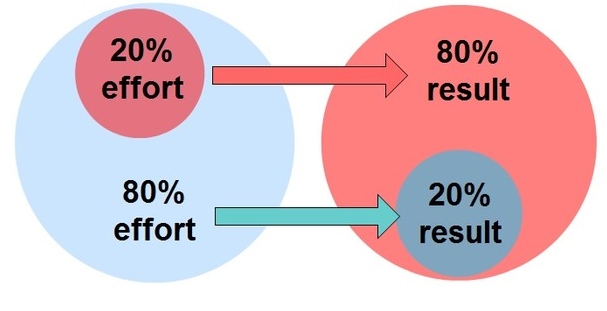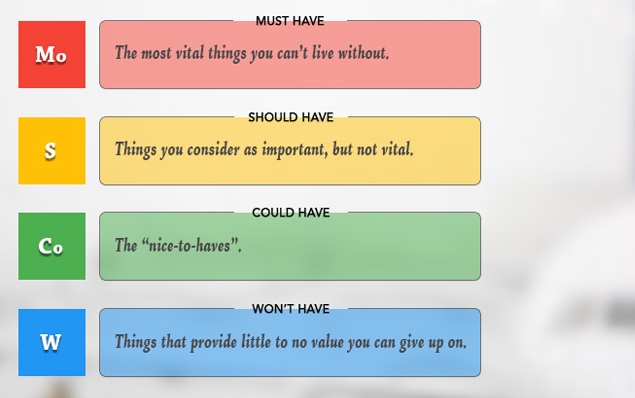MoSCow Method: the Most Successful Prioritization Technique For Any Project
October 26, 2016 / Estimated reading time: 6 minutes

“You do not need to do work faster or to eliminate gaps in productivity to make better use of your time. You need to spend more time on the right things…”
Ray Johnson
How does it feel when you get up early in the morning and have so much to do? Everyone surely knows that feeling, right?
We always have many routine things to do, and there is not enough time and energy to manage them all. No time, no resources, and we even don’t know where to start. Besides, many issues can be left undone. You know what? It’s a high time to think about prioritization.
Prioritizing your stuff with special prioritization techniques or methods may solve this problem. And if you are able to set SMART business goals and know how to identify a critical path in project management, the new project management method will bring your business to success.
However, how can we determine which tasks or issues are of the highest priority?
This article describes one of the easiest prioritization techniques and how it should be used in business analysis and Agile project management.
How to prioritize if everything is a priority?
Prioritization is your ability to see which tasks and objectives are more important at the current moment and give them more time, attention, and energy. Sometimes we should choose between three, five or more tasks: to fill a regular report, arrange meetings, make some calls to customers, have a dinner with business partners, and so on and so forth.
While determining your priorities, try to focus on what is more important at the expense of lower value activities.

Prioritization techniques and methods: first things first!
In order to build a castle you need to start somewhere. Before diving into specific prioritization techniques, pay attention to the basic planning tips that can help you to concentrate on the essentials.
List your plans
Every morning make a list and write down everything you need to get during the day. Separate the issues into urgent and not urgent and determine priorities.
Set values
You can feel that completing certain tasks will bring you more benefits than completing others. Just try to imagine what will happen if you do not complete the task.
Set real goals
Before creating your list of priorities, be realistic about your bandwidth.
Be Flexible
You should be ready for changing your priorities and manage them effectively.
Do not forget about other issues
When something is important, it’s quite easy to get caught up in details. Spending too much time on one priority, you can forget about other objectives. Try to be focused on everything you are responsible for.
80/20 prioritization rule
80/20 Rule is the key reason why the system of prioritization works. According to this technique, 80% of typical activities contribute something like 20% to the value of our work. It means that 80% of the project’s benefits come from 20% of the time spent by its staff. When you do only the most important 20% of your tasks, you get most of the value.
But how can we define what tasks must be included in this 20%?

One of the most essentials parts of any project in software development is requirement prioritization. It is especially important in Agile development methodologies.
What is the most successful requirement prioritization technique?
If you ask your friends or search engines about the most helpful requirements prioritization techniques, it will list several options: Needs-Based Analysis, Crowd Sourcing, Opportunity Scoring, etc. But the most popular answer among them is MoSCoW prioritization technique.
Moscow technique as one of the easiest methods for requirement prioritization
MoSCoW method’s name has nothing in common with the capital of Russia. The acronym MoSCoW was developed in 1994 by Dai Clegg. People have added double “o” inside the acronym to make it pronounceable. It’s better to write them in lowercase to highlight that they don’t have any sense.
MoSCoW method is the prioritization technique that is originating from the dynamic software development method (DSDM). According to this technique, you can categorize your list of requirements into the following groups:
M – Must have
This point describes requirements that must be satisfied in the final solution. These requirements are non-negotiable. And the project will fail without them.
S – Should have
A high-priority feature that is not critical to launch. But it is considered to be important and of a high value to users. Such requirements occupy the second place in the priority list.
C – Could have
A requirement that is desirable but not necessary. According to the method, this point will be removed first from scope if the project’s timescales are at risk.
W – Won’t have
A requirement that will not be implemented in a current release but may be included in a future stage of development. Such requirements usually do not affect the project success.

After this classification, all requirements are ranked in order of preference within every category. Project managers should feel the balance and be sure the project has enough Must, Should, Have and Could have requirements.
Let’s have a look how MoSCoW prioritization technique works with a simple example:
You are going to buy a motorbike with an extra seat to travel with your friend on the weekends. The bike should have a low seat and a four-cylinder engine. Unlimited mobility is also important. Your favorite color is red, so you want to have a red color body. You also want to get good wind protection.
It would be also nice to have Bluetooth connectivity for your iPod. In addition, you are fond of having a helmet with a double ventilation system…
Let’s define prioritization:
M – a new bike for traveling, an extra seat.
S – a low seat, a four-cylinder engine. Unlimited mobility.
C – a red color body, extra wind protection.
W – Bluetooth and a helmet with a double ventilation system.
It seems that MoSCoW prioritization technique really helps to highlight the most important thing, right?

Here is a funny and descriptive example of MoSCoW prioritization technique:
Advantages and disadvantages of MoSCoW model
MoSCoW prioritization technique can really help you to rank and classify items in order to get a successful product. The key benefits of the method are:
- MoSCoW technique is based on expert opinion of the team.
- It is quick and easy to complete.
- The technique is good in defining the priorities of projects that are in progress.
The key assumptions and the weakest points are:
- MoSCoW rules can be subjective. If there is no effective cooperation with business, this prioritization method may be inaccurate.
- The technique requires the team to have good familiarity with the product features. When the participants have different levels of familiarity with the product, it is difficult for them to classify or rank the items. In this case, their expert conclusions will be unhelpful.
And that’s it!
Do not forget that it’s quite easy to organize and prioritize tasks with Gantt Chart templates. Using Gantt Chart – GanttPRO, you can schedule your tasks, set priorities, define strategies and keep track all the results.
What do you think about MoSCoW prioritization technique? Do you need more details about the method?
Let us know if you have any questions!

Wow! You have a strong professional presence. Keep up the good work.
I would like to share some tips which personally helped me
on The Most Popular Prioritization Techniques and Methods axisbits.com/blog/The-Most-Popular-Prioritization-Techniques-and-Methods-to-Use
Hi there,
I was wondering what you would consider a real life example of using this technique?
Nicely explained. Thank you